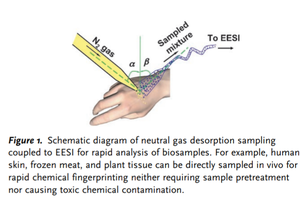Neutral Desorption Sampling of Living Objects for Rapid Analysis by Extractive Electrospray Ionization Mass Spectrometry
H. Chen, S. Yang, A. Wortmann, and R. Zenobi
Abstract: Mass spectrometry is increasingly used for research purposes and routine measurements in biology, life science, the pharmaceutical industry, and in clinic diagnosis to characterize complex samples. Usually, biological samples are mixtures supported by a biological structure such as skin, tissue, muscle, or vessels and are commonly accompanied by microorganisms. Owing to ion suppression effects, the matrix must traditionally be carefully removed, usually in a time-consuming process (e.g. extraction, separation), before mass spectrometric analysis. This processing renders high-throughput analysis difficult.
Remarkable efforts to enhance analysis throughput of mass spectrometry were made by Cooks and co-workers with the invention of desorption electrospray ionization (DESI). DESI, as well as DART (direct analysis in real time), directly analyzes complex solid surfaces with minimal sample pretreatment, although the sample can also be a liquid such as urine. In DESI, ion suppression is reduced, because analyte ions are created by reactive collisions between the analyte molecules supported by a solid substrate and the primary ions generated by an electrospray. Recently, Chen et al. demonstrated that liquid samples can be analyzed directly in real time using extractive electrospray ionization (EESI), in which ions of analytes are created by charge-transfer collisions between the primary ion cloud generated in an electrospray and a neutral sample plume generated by a separate spray beam. Thus, ion suppression is significantly reduced in EESI by dispersing the sample over a relatively wide space. Previous studies show that EESI tolerates complex matrixes.
Herein, we report a novel method using a neutral gas stream to sample the surface of solid biological objects for in vivo EESI mass spectrometric analysis of living matter without sample pretreatment. The sampling process is totally separated from the ionization process, which results in rapid in vivo analysis of biological surfaces with reduced ion suppression and without chemical contamination.


